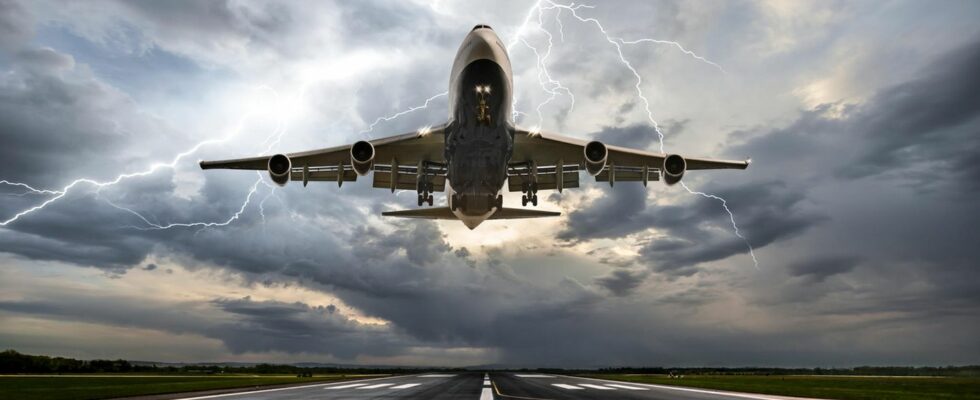There was severe turbulence during a flight from London to Singapore. Many passengers were injured and one man died. How does turbulence arise? And how dangerous are they? An overview.
On Tuesday there was severe turbulence during a flight from London to Singapore. The Singapore Airlines plane suddenly dropped dramatically, throwing people to the ceiling. “Some people hit the luggage rack with their heads and dented it, hit the places where the lamps and masks are and broke it,” a passenger told the BBC. More than 70 passengers had to be treated in hospital after the emergency landing in Bangkok, seven of whom were seriously injured. A man died in the accident. A nightmare scenario.
How does turbulence arise? How dangerous are they? And which routes are particularly often affected? We answer the most important questions at a glance.
How do turbulences arise?
You’re just gliding gently above the clouds, the weather is good, the sky is calm. Then the plane suddenly drops and your heart sinks into the pit of your stomach. Even though turbulence is primarily associated with bad weather, such as thunderstorms and storms, it can also occur when the view from the window promises a gentle flight.
Turbulence is caused by “chaotic” air movements or turbulence. Even the weather radar sometimes cannot detect them. In so-called wind shear, different air masses cross each other, causing the speed and direction of the wind to change over a short distance. “The shorter the distance over which the change in direction or speed occurs, the stronger the shear,” describes the “German Weather Service”. Low-level wind shear, i.e. wind shear at low altitudes, is primarily crucial for aircraft.
Such turbulence can, but does not necessarily have to be, dangerous. However, wind shear can become problematic, especially during the take-off or landing phase, if it causes the aircraft to suddenly sink or rise. In this context, people often incorrectly talk about air holes. In the current case of the Singapore Airlines flight accident, data from the Flightradar platform indicate that the Boeing sank by almost two kilometers.
How dangerous is turbulence?
Turbulence is divided into four categories: light, moderate, strong and extreme. If turbulence occurs, passengers are usually asked by flight staff and the flare to sit down and fasten their seatbelts. In any case, it is recommended that you remain seated in your seat for the entire flight. Also because turbulence can occur without warning, so-called clear air turbulence.
In light turbulence, little more than a jerk is to be expected. In strong turbulence, however, the vertical movement of the aircraft exceeds the pull of gravity, explains Thomas Guinn to the New York Times. Guinn is a professor of applied aeronautical science at Embry-Riddle Aeronautical University. He says: “That means that if you’re not wearing a seatbelt, by definition you become a projectile, you’re a catapult, you’re lifted out of your seat.” It can also be dangerous if luggage and other items fly through the plane due to turbulence.

Passenger Alan Cross documented the chaotic conditions on the Singapore Airlines plane after the turbulence.
© Alan Cross/Exclusivepix / Action Press
In the plane accident on Tuesday, everyone who was not wearing a seatbelt was reportedly thrown to the ceiling. Most of the injuries were caused by head impacts, according to Bangkok airport director Kittipong Kittikachorn.
Are there flight routes where turbulence occurs particularly frequently?
Turbulence occurs more frequently on some flight routes. Among other things, flights over mountains are affected, as the air is particularly turbulent in the area of the mountain peaks. Things can get restless when flying over the Alps or, for example, over the Rocky Mountains. Turbulence also occurs regularly when flying over the Black Sea, the Equator or the North Atlantic.
Turbli.com publishes a list of the most turbulent flight routes. In 2023 the top 5 were: Santiago de Chile (Chile) – Santa Cruz (Bolivia); Almaty (Kazakhstan)–Bishkek (Kyrgyzstan); Lanzhou (China)–Chengdu (China); Nagoya (Japan)–Sendai (Japan); Milan (Italy) – Geneva (Switzerland).
Lufthansa Allegris
This is what the new seats look like in all travel classes
Will turbulence increase in the future?
Researchers at the University of Reading in the UK assume that the risk of turbulence is increasing. For a study, they evaluated data from 1979 to 2017 and found that there has indeed been an increase in turbulence over the past 40 years. The researchers believe that this is due to climate change, which is changing wind conditions. In the future, this will lead to more wind shear.
They have identified the areas over the USA and the North Atlantic as particularly affected. The reason for this is that the area south of the jet stream is warming more than the area in front of it. The increasing temperature differences also result in stronger wind shear and therefore stronger turbulence.
source: Study Turbulence, German Weather Service, New York Times, The Telegraph,tv.se,daily News, Mirror,Aerotelegraph, Turbly, BBC

